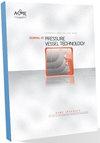On The Strength And Tightness Of Asme B16.5 And B16.47 Series A Standard Flanges
IF 1.4
4区 工程技术
Q4 ENGINEERING, MECHANICAL
Journal of Pressure Vessel Technology-Transactions of the Asme
Pub Date : 2023-11-10
DOI:10.1115/1.4063890
引用次数: 0
Abstract
Abstract ASME flanges are extensively used in the pressure vessels and piping industry. The origin of their class and size is not based on the amount of initial bolt load they can carry nor the level of tightness they can achieve. Their PV rating does not give an indication on the level of stress they are subject to and little is known on their ability to withstand the maximum bolt stress level they can be subjected to during initial bolt-up or under operation. The integrity and leak tightness of ASME B16.5 and B16.47 series A flanges made of SA105 material need to be analyzed individually in order to identify the flange classes and sizes that are more vulnerable to the bolt stress level. This paper proposes the use of an accurate analytical model to appropriately address the integrity and leakage tightness of the complex statically indeterminate weld neck standard flange connections based on the flexibility and the elastic interaction between the different joint elements. As such, the most critical standard flanges in terms of class and size will be identified in order to avoid failure. The model is first tested and validated using finite element method simulations on different sizes of class 900 flanges. The study investigates the effect of the initial bolt preload on parameters such as flange rotation and stresses in the flange, gaskets, and bolts. The most critical size and class flanges and their highly stressed locations will be revealed.Asme B16.5和B16.47 A系列标准法兰的强度和密封性
摘要ASME法兰广泛应用于压力容器和管道行业。它们的等级和尺寸的起源不是基于它们所能承载的初始螺栓载荷的大小,也不是基于它们所能达到的紧密程度。它们的PV额定值并没有给出它们所承受的应力水平的指示,而且对于它们在初始螺栓连接或运行期间所能承受的最大螺栓应力水平的能力也知之甚少。用SA105材料制成的ASME B16.5和B16.47系列A法兰的完整性和密封性需要单独分析,以确定更容易受到螺栓应力水平影响的法兰等级和尺寸。基于不同连接单元之间的柔性和弹性相互作用,提出了一种精确的解析模型,以适当地解决复杂的静不定焊颈标准法兰连接的完整性和泄漏密封性问题。因此,就等级和尺寸而言,将确定最关键的标准法兰,以避免失效。首先对900类不同尺寸的法兰进行了有限元模拟,验证了模型的有效性。该研究调查了螺栓初始预紧力对法兰旋转和法兰、垫片和螺栓应力等参数的影响。最关键的尺寸和等级的法兰和他们的高应力位置将被揭示。
本文章由计算机程序翻译,如有差异,请以英文原文为准。
求助全文
约1分钟内获得全文
求助全文
来源期刊
CiteScore
2.10
自引率
10.00%
发文量
77
审稿时长
4.2 months
期刊介绍:
The Journal of Pressure Vessel Technology is the premier publication for the highest-quality research and interpretive reports on the design, analysis, materials, fabrication, construction, inspection, operation, and failure prevention of pressure vessels, piping, pipelines, power and heating boilers, heat exchangers, reaction vessels, pumps, valves, and other pressure and temperature-bearing components, as well as the nondestructive evaluation of critical components in mechanical engineering applications. Not only does the Journal cover all topics dealing with the design and analysis of pressure vessels, piping, and components, but it also contains discussions of their related codes and standards.
Applicable pressure technology areas of interest include: Dynamic and seismic analysis; Equipment qualification; Fabrication; Welding processes and integrity; Operation of vessels and piping; Fatigue and fracture prediction; Finite and boundary element methods; Fluid-structure interaction; High pressure engineering; Elevated temperature analysis and design; Inelastic analysis; Life extension; Lifeline earthquake engineering; PVP materials and their property databases; NDE; safety and reliability; Verification and qualification of software.

 求助内容:
求助内容: 应助结果提醒方式:
应助结果提醒方式:


